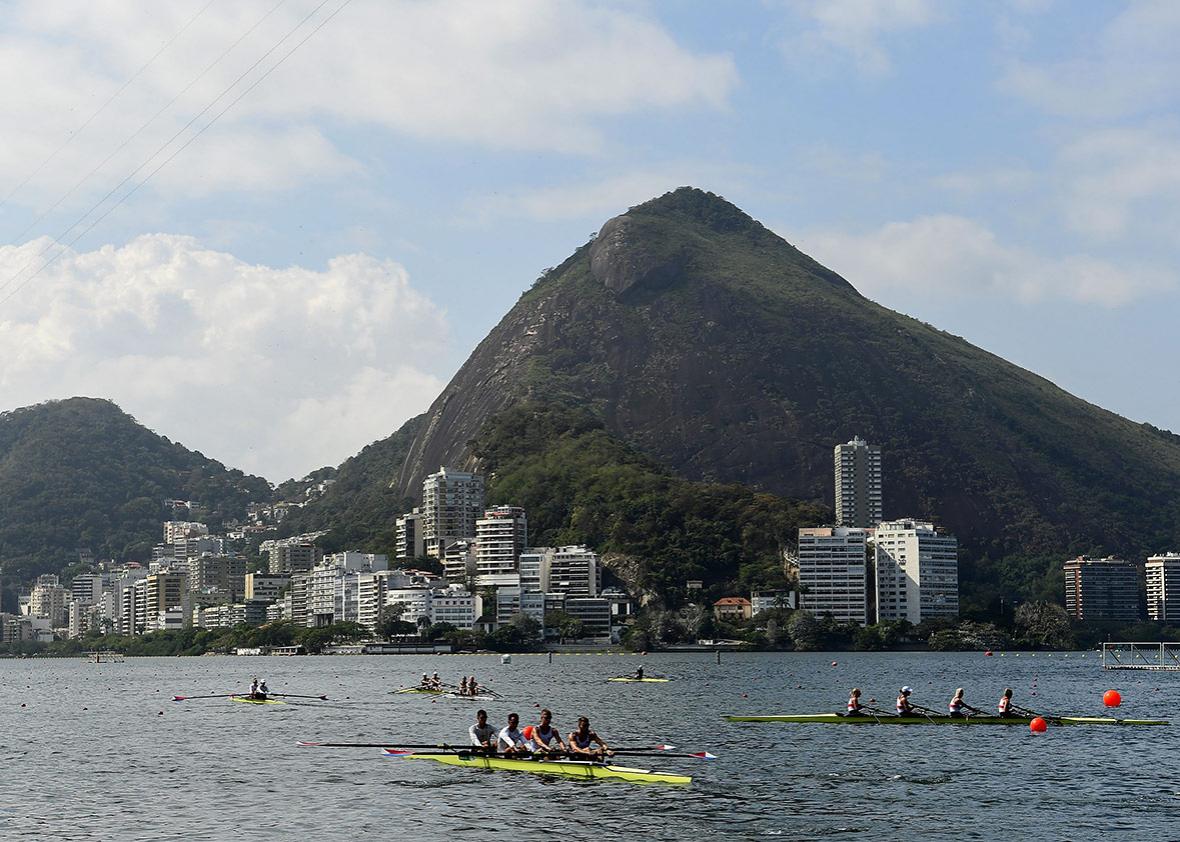Of the 11 Olympic sports that involve water, five—canoe sprint, marathon swimming, rowing, sailing, and triathlon—take place in the open water. Unfortunately, for the 2016 Games in Rio de Janeiro, the open water in which these events will occur is contaminated with waste, raw sewage, and other unsavory deposits. This is not great for the athletes participating in these sporting events.
When Rio was vying for this year’s Olympics back in 2009, it pledged to spend $4 billion on water treatment and sanitation as part of its official bid, an attempt to remedy the health hazards posed by the untreated sewage in the Guanabara Bay. According to the New York Times, to date, officials have spent just $170 million—less than 5 percent of the pledged total.
The water is still contaminated, of course, and the health risk is still real. But locals swim in the Guanabara Bay and even drink from it. So if they aren’t they getting sick en masse, why is it risky for the athletes? Locals are more likely to have developed resistance to the strains of microbes that are present in the waters and can make people sick, says Stephen Morse, virologist and professor of epidemiology at the Columbia University Mailman School of Public Health.* In fact, as many as 60 percent of Brazilians have been infected with hepatitis A, an illness that can result from sewage exposure, at some point in their lives. Athletes from other countries—even those who have been immunized against the very viruses present in the water—will likely not be so fortunate to have resistance to the local strains.
Bacteria and viruses that make us sick thrive in fecal matter. The problem with swimming through contaminated water is that the bacteria can get into our mouths and eyes and ears in such high concentrations that it’s pretty easy to get sick. It all depends on exposure, but a few inadvertently swallowed mouthfuls of water can contain enough infective microbes to do the trick.
“Best thing you can do is avoid as much as possible contact with the water,” says Morse. Of course, that’s not really an option for the Olympians.
The worst-case scenario here is contracting hepatitis A, which lasts anywhere from a few weeks to a few months. Fortunately, the far more likely scenario is a relatively short-lived (but still decidedly unpleasant) viral infection, which would result in a few days locked in the bathroom, either with diarrhea or incessant vomiting (or both). Also, it takes long enough to hit the system that athletes won’t have to worry about getting ill during their events.
When it comes to risk of infection from Rio’s waters, here’s how the open-water events stack up. (Athletes participating in canoe slalom, diving, modern pentathlon, swimming, synchronized swimming, and water polo can rejoice—all of these events take place in artificial waterways.)
5. Sailing
As astutely noted by Dutch sailing team member Afrodite Zegers in a comment to the Times, “We just have to keep our mouths closed when the water sprays up.” This marks one of the categorical advantages enjoyed by the 380 athletes competing in the sailing events this year: They’re the farthest away from the water. Sailors could even easily sport mouth-covering protective gear, as well as goggles, Morse says.
4. Rowing
“Even when you’re rowing, you have water splashing up in your face,” said Morse. As for the members of the rowing team, masks and goggles are still an option for reducing risk.
Having either not heard or not heeded such advice, in 2015, 13 members of the U.S. rowing team became violently ill after a trip to Rio for the World Junior Rowing Championships. They competed in a lagoon that tested positive for a so-called super bacteria and came down with an unidentified stomach illness, which lasted up to a week in some athletes.
That doesn’t bode well for the remainder of this list.
3. Canoe sprinting
This strange sport has been around since the infamous 1936 Games in Nazi Germany and involves athletes on one knee, paddling furiously, either solo or in groups. It’s like rowing, but you’re facing forward, and you’re closer to the water.
The sport’s events are taking place in the Rodrigo de Freitas Lagoon, where local microbiologist Renata Picão found unusually high levels of drug-resistant bacteria in several parts of the water in 2014. Canoe sprinters will likely be enviously eyeing the events of their sport’s sister, canoe slalom, which is fortunately being held in an artificial waterway.
2. Triathlon
An independent investigation, conducted last year by the Associated Press in conjunction with Brazilian virologist Fernando Spilki, found levels of adenovirus and enterovirus comparable with that found in raw sewage at Copacabana Beach, where triathlon and marathon swimming are scheduled to take place. Triathletes also can’t really sport protective masks. Strains of hepatitis A and other viruses will be free to float into mouths of any athletes who aren’t careful enough to keep theirs closed—a tough task when you’re going for gold.
1. Marathon Swimming
No way around it—this sport is the absolute worst. As Rio pediatrician Daniel Becker told the New York Times, like the triathlon swimmers, marathon swimmers “will literally be swimming in human crap.” Unfortunately for the marathon swimmers, they’ll be going almost seven times as far. That means the risk of exposure is simply lengthened, thus raising the chances that an infection will occur.
Best of luck!
See more of Slate’s Olympics coverage.
Correction, Aug. 2, 2016: This story originally stated that Stephen Morse worked for Columbia University’s Medical Center. He works for the Columbia University Mailman School of Public Health. (Return.)
